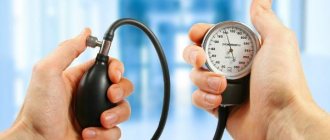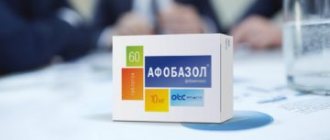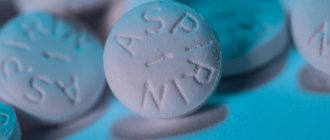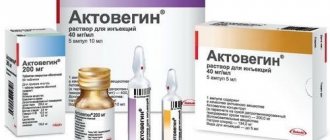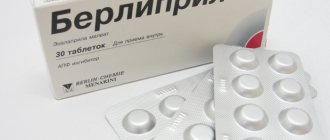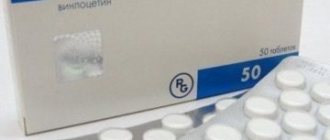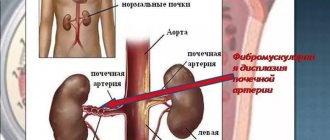Home » Articles from an expert » Drugs
People suffering from hypertension do not always pay attention to whether Paracetamol and blood pressure are combined with each other. They take antipyretics without the doctor's knowledge if they have flu or cold symptoms.
The antipyretic Paracetamol is one of the main components of many modern drugs; those with high blood pressure should take it especially carefully.
Composition of the drug and indications for use
The drug has several forms of release:
- Pills;
- Syrup;
- Suspensions for adults and children;
- Suppositories for adults and children.
They differ in the proportion of active substance content and the composition of additional components, most of which are of plant origin. As a result, the drug has virtually no negative effect on the gastric mucosa. Each release form has its own instructions for use.
The medicine belongs to the group of non-steroidal anti-inflammatory drugs and is used as a symptomatic analgesic and antipyretic. It effectively reduces fever and relieves moderate pain, but does not have an anti-inflammatory effect. The use of paracetamol will not give the desired result for pain caused by inflammatory processes, for example:
- inflammation of muscles and joints;
- ligament and tendon injuries;
- bruises.
Main indications for use:
- toothache, headache, menstrual pain:
- aches in muscles and joints;
- migraine;
- fever caused by colds.
The dosage and frequency of taking the medicine depend on the age of the patient. If the use of the drug does not give the expected effect in a short time or the condition worsens, then you should consult a doctor.
Taking the drug in conditions of pathologies of the cardiovascular system
For low and high blood pressure, Paracetamol is taken according to the general regimens presented in the instructions. There are several forms of medication (syrups, powders, suspensions, suppositories and tablets with different concentrations of the active substance), but adults prefer to take tablet forms. Paracetamol for high blood pressure or in case of hypotension, if indicated, is taken as follows:
- tablets are taken in a dose of 325-500 mg at a time (one tablet may contain 200, 325 or 500 mg of the active substance, which you should definitely pay attention to during treatment);
- the daily dose for an adult should not exceed 4 grams;
- the number of doses per day is 3-4 at intervals of 5 hours, but in emergency cases it is possible to reduce the intervals between tablets;
- the medicine is washed down with plenty of water, especially in the case of relief of hyperthermia (lack of fluid can lead to the fact that the drug will not work);
- The drug is taken after meals.
Even if the medicine slightly lowers or increases blood pressure, this does not affect the general well-being of the patients. More important is the toxic effect of Paracetamol on the liver, which should not be forgotten. Liver failure may occur due to an overdose or prolonged (more than 3 days) use of the drug.
The effect of paracetamol on blood pressure
During a cold, an increase in temperature is often accompanied by a headache. Paracetamol is a good antipyretic, but is not always effective in relieving pain. Sometimes it is taken in combination with other medications. You should not select combinations of medications on your own, because headaches can be caused by increased blood pressure. In order to combine medications correctly, you need to know how they affect the body and how they affect blood pressure.
Hypertension is a common disease that affects the functioning of the cardiovascular system. The age of people at risk is decreasing every year. This is due to constant psychological overload, poor diet and lack of sleep. One of the symptoms of high blood pressure is a headache in the back of the head. Paracetamol is one of the TOP painkillers, but its use for high blood pressure is not recommended.
It is not easy to answer the question whether paracetamol increases blood pressure. It reduces the effectiveness of medications used to lower blood pressure. In this case, it is possible to review the dosage of medications for hypertension. In general, the effect of paracetamol on blood pressure cannot be called unambiguous. If the instructions for use are followed, a short-term increase in this indicator is regarded as a minor side effect. However, the individual reaction of the body can lead to negative results from using the medicine.
Important!!! The use of pure paracetamol and drugs based on it is contraindicated in patients who have suffered a heart attack or stroke.
Paracetamol can be taken with high blood pressure only in exceptional cases when you need to quickly lower the temperature.
Compound
Contains only herbal ingredients, in particular, a collection of 8 medicinal plants. As a result, it is characterized by relative safety of use, of course, provided that it is taken in accordance with the instructions and recommendations of specialists. This circumstance makes it an effective means of combating the symptoms of diseases such as atherosclerosis, myocardial infarction, arrhythmia, coronary artery disease and heart failure. One tablet of this medicine contains:
- paracetamol directly (0.2 g);
- sodium stearate and carboxymethyl starch.
The medicine easily breaks down in a solution that contains alcohol and practically does not react to water, that is, when interacting with it, it is in no hurry to change its structure.
Rules for using paracetamol for blood pressure
Paracetamol does not lower blood pressure when taken as a pain reliever. However, when using the drug for fever, hypertensive patients may experience a slight decrease in blood pressure. This effect is not related to the action of the active substance on the body. Since the medicine is an effective antipyretic, this is a reaction to a sharp drop in temperature. As a result, the patient may feel dizziness, drowsiness and weakness - the main symptoms of low blood pressure.
If the dosage is observed, the active substance does not have a great effect on the functioning of the cardiovascular system, so taking paracetamol for low blood pressure does not make much sense. For this, there are other antipyretics, for example, citramon, which contains caffeine. This medicine can help hypotensive patients, but it will only harm those who suffer from hypertension.
Basic recommendations when taking medication for patients with impaired functioning of the cardiovascular system:
- use the drug for no more than 4 days, since it relieves the symptoms of the disease, but is used for treatment;
- do not exceed the daily dose agreed with your doctor;
- start taking paracetamol-based combination products with small doses to make sure there are no allergic reactions to the components.
Important!!! It is better for hypotensive patients to take combination medications containing paracetamol, but do not forget about individual intolerance to some substances. Taking a drug containing caffeine can cause a sharp increase in blood pressure and trigger a headache.
General pharmacological action of Paracetamol
The product has almost no contraindications, provided that the dosage prescribed by the doctor is followed. The daily dosage of the drug should not exceed 4 g, and no more than 1 g of medication can be taken at a time.
Paracetamol has the following effect on the body:
- Antipyretic. It reduces fever perfectly, relief occurs within 30-40 minutes after taking the medicine.
- Painkiller. Relieves mild headaches, muscle and joint pain. But if the pain is very severe, the drug will be ineffective.
- Anti-inflammatory. The product helps with minor inflammation. But this property is very weakly expressed in him.
The drug affects pain centers and also helps regulate temperature in the brain. It also affects the synthesis of prostaglandins, which affect body temperature and increase pain sensitivity.
Adverse reactions and contraindications of paracetamol for low or high blood pressure
When paracetamol is used correctly, the risk of side effects is minimal, but it still exists. Taking the medicine may cause the following reactions:
- from the cardiovascular system: decreased myocardial contractile function;
- from the digestive system: nausea, epigastric pain;
- from the hematopoietic system with long-term use: anemia, decreased number of platelets in the blood;
Allergic reactions in the form of rashes and swelling are possible.
An overdose of the active substance leads to liver intoxication. Other symptoms of poisoning include drowsiness and dizziness, as with low blood pressure. However, if, against the background of these phenomena, nausea, vomiting occurs, or the color of the skin changes (increased pallor or cyanosis), you should consult a doctor. In case of paracetamol poisoning, immediate hospitalization is indicated.
Doses of the drug and its effect on the body
It is necessary to take no more than four grams of medicine per day. You can only take one gram at a time. After using the drug, a person's blood pressure may increase, but not much. However, it should be noted that such an effect of the drug cannot worsen the patient’s condition too much.
The annotation for the drug does not indicate how paracetamol affects a person - whether it increases or decreases blood pressure.
But it is known for sure that it affects headaches by eliminating them. After all, it can occur at any pressure, high or low. However, experts say that it is not necessary to take this drug to stabilize blood pressure. They take completely different medications for blood pressure.
And it helps with headaches and high body temperatures. It must be remembered that paracetamol does not affect blood pressure, so it is not prescribed or taken in such cases. If your blood pressure is high, then this remedy should be taken carefully so as not to cause irreparable harm to your health.
You should also remember about individual intolerance, because this medicine can relieve a high fever for someone, and a toothache for someone else.
Contraindications
The list of restrictions and contraindications for the drug is quite small:
- allergy to the active substance or components included in the medicinal product;
- pathologies of liver or kidney function;
- the patient's age is less than 3 years.
The drug should be taken with caution in the following cases:
- increased levels of bilirubin in the blood;
- presence of viral hepatitis;
- liver damage caused by alcohol addiction;
- alcohol abuse;
- pregnancy and lactation;
- old age.
The drug should not be used simultaneously with other drugs containing paracetamol to prevent an overdose of the active substance.
Other options
The interaction of the drug with various substances entails consequences. Their nature depends on concomitant medications. Therefore, they influence how it reduces or increases vascular compression. Using:
- Caffeine. The effect is enhanced. The temperature decrease occurs with double force due to the greater concentration of the active substance; in addition, energy recharging occurs. A drug containing caffeine and paracetamol at the same time is Panadol Extra.
When taking Citramon, the tonometer readings increase, but not due to the Paracetamol contained in the composition
- "No-shpy." Through this combination, painful symptoms and spasms of blood vessels are effectively relieved. Most often used to alleviate the condition in children under three years of age.
- "Analgina." Interaction that brings quick positive results. The main condition for using this method was the absence of taking other anti-inflammatory drugs.
- "Aspirin." They have similar effects, so their parallel use would be unnecessary. It is also fraught with a negative effect on the liver.
- "Ibufena." Assignment is not possible since they have the same purpose. Ibufen is considered more effective, so Paracetamol is often replaced with it.
- "Nurofena". Combined use helps in cases where one drug cannot cope. The main necessity is to maintain intervals between their adoption. Experts note fewer negative consequences after Nurofen.
- "Suprastina." This interaction is used when it is necessary to relieve symptoms of fever. On the one hand, there is an antipyretic effect, and on the other, an antihistamine effect.
In any case, whether Paracetamol increases or decreases blood pressure, its use must be approved by a doctor.
Interaction with other substances
Even if there are no contraindications for the use of paracetamol tablets, the effectiveness of its action depends on its interaction with other drugs:
- the use of oral hormonal contraceptives accelerates the removal of the substance from the body and reduces its analgesic effect;
- the use of certain drugs that have a depressant effect on the central nervous system, as well as anticholinergic drugs, reduces the antipyretic properties of the drug;
- ethinyl estradinol accelerates the absorption of paracetamol in the intestine;
- metoproclamide increases its content in blood plasma;
- the substance reduces the rate of elimination of lamotrigine and diazepam from the body;
- alcohol and antibiotics enhance the toxic effect of the drug on the pancreas and liver.
Paracetamol is often combined with other drugs in the complex treatment of colds:
- combination with no-shpa and analgin relieves spasms and pain. Often used to alleviate the condition of children under 3 years of age;
- combination with aspirin or analgin guarantees the elimination of fever and pain in a short time. Recommended only if other anti-inflammatory drugs are not used;
- suprastin in combination with paracetamol is used to relieve symptoms of fever. In this case, the body has an antipyretic and antihistamine effect.
When taking any medications in a course, before choosing an antipyretic drug, you should consult with your doctor and not self-medicate.
Assessing the effect of the active substance on the body, experts agree that taking paracetamol with high blood pressure is not advisable, even if the instructions for use are followed.
Description
Paracetamol (Paraacetylaminophenol) has a clear ability to lower body temperature. It also has an analgesic effect. It is also used to relieve inflammation.
The drug is absorbed in the intestine quite quickly. After a short time it is already present in all tissues. Metabolized in the liver. It is removed from the body by the kidneys. The maximum concentration is achieved half an hour after administration. The elevated body temperature will begin to gradually decrease 1.5-2 hours after consumption. The half-life is 2-4 hours.
If you take Paracetamol for a long time in large quantities, liver damage cannot be ruled out.
Indications:
- headache;
- neuralgia;
- algodismenorrhea;
- toothache;
- arthralgia;
- toothache;
- joint discomfort;
- myalgia;
- heat;
- body aches;
- general weakness.
Benefits of use
Paracetamol is usually used during ARVI and influenza. Its antipyretic property is mild and close to the natural decrease in readings on a thermometer. The compound can affect the central nervous system and is localized in the hypothalamus. This is due to the impact on thermoregulation processes. The human defense system is activated. After all, now you don’t need to waste energy on eliminating fever.
Paracetamol is prescribed to children, including. The action is selective. Due to its intake in small quantities, methemoglobin is formed and this causes harmful effects. But Paraacetylaminophenol has no effect on platelets. It is also not able to influence the enzymes cyclooxygenase-1 and 2. This is the big advantage of the drug over other antipyretic tablets often used for acute respiratory viral infections.
Basic principles of treatment
Paraacetylaminophenol is not an antibiotic at all. It also does not apply to vitamins. This is a symptomatic remedy. It is necessary to alleviate symptoms during an acute viral infection. The compound does not fight the disease itself.
You should always strictly follow the dosage recommended by your doctor. It is used for acute forms of ARVI, accompanied by elevated temperature.
You cannot combine the intake of alcohol-containing substances with Paracetamol.
Dosages
Pills
Adults can take 1.5 g of Paracetamol at a time - this is the maximum allowable dose. As a rule, the medication is taken several times a day, usually 3-4 in an amount of 0.35-0.5 g. The daily dosage should not exceed 3-4 g of the active substance. According to the instructions, you should take the drug after meals. You need to take it with water; you should not use any drinks.
Dosages are similar to those used for tablets. It is necessary to count the number of grams of the active compound and not exceed the permissible limit.
Directions for use and doses
The medicine should be taken after meals.
Tablets and syrup should be taken after a heavy meal. The tablets should be taken with plenty of water. Use in the range of up to 4 g per day and up to 1 g in a single dose is quite acceptable. You can take the drug for up to 3 days. Children are usually prescribed suppositories or syrup. For adults, tablets are more effective. The effect occurs within 15-20 minutes after administration, but the concentration in the blood plasma reaches its maximum amount after 30-60 minutes. The half-life period for elimination from the body is 1-4 hours. It is important to remember that self-medication is harmful to our health. You should not prescribe medicine yourself, but rather consult a specialist.
Return to contents
Taking antipyretics for hypotension
For hypotension, paracetamol cannot increase blood pressure, so taking the drug is not prohibited.
There are a number of drugs based on paracetamol that can slightly increase blood pressure - these are Citramon, Farmadol, and other drugs with a similar composition. These tablets contain only three components:
- acetylsalicylic acid;
- paracetamol;
- caffeine.
The drugs have antipyretic and analgesic effects. Due to the caffeine in the composition, an increase in blood pressure may be observed, but, as a rule, it is insignificant. This effect wears off quite quickly. There is less caffeine in one tablet of these drugs than in a cup of coffee - only 30-50 mg, depending on the dosage.
With hypotension, such medications can be taken, while hypertensive patients may feel worse with very high blood pressure.
To increase blood pressure for headaches caused by hypotension, medications with paracetamol and caffeine can be taken, but their effect is weak, so there may be no effect.
For hypotension, you can take either paracetamol or caffeine-containing medications.
Properties and release form
The second name of the drug is “Acetaminophen”. There are many medicines on pharmacy counters with different names, but containing the same active ingredient - paracetamol. It is classified as a drug that can be used to alleviate the patient’s condition and relieve cold symptoms.
The drug reduces fever, provides relief for colds and is a synthetic non-narcotic drug. The active substance inhibits prostaglandins, which stimulate the thermoregulation center in the hypothalamus. At this moment, the sensitivity to various stimuli of a chemical or mechanical nature in nerve cells decreases. Thus, an analgesic effect occurs. But the tablets do not have anti-inflammatory properties. Depending on age, the medicine has different degrees of effect. For example, toxic metabolic products are not formed in children under 12 years of age. The highest absorption is achieved in the gastrointestinal tract. But the process may slow down when taking adsorbents or drugs that reduce gastric acidity.
Paracetamol is produced in several forms:
- dry powders containing the active substance;
- syrup;
- rectal suppositories;
- pills.
Return to contents
Correct use of the drug
This drug affects each person individually. Therefore, when using it to treat children, you must be extremely careful. It should also be said that it has a more toxic effect on the children's body, although it is prescribed by pediatricians. And it can only be used after six years.
This medication should be taken for colds, respiratory viruses and flu. The breakdown products of this drug are removed from the body by the liver. And if there are serious pathologies of this organ, this remedy is not recommended.
To find out whether this drug has blood pressure-increasing effects, you should consult an experienced doctor. Many doctors note that it raises blood pressure.
Today, the maximum dose of the drug per day should not exceed four grams, although quite recently, this norm was only one and a half grams per day.
If a person has big problems with blood pressure readings, then it is better to take this drug under the strict supervision of a doctor. But small doses can be taken independently.
Is it possible to drink this remedy? You should consult an experienced specialist about this. Only a doctor will tell you about this drug in more detail. He will also tell you whether you can take it or not. Recently, a decrease in the susceptibility of the drug by our body has been noticed, so its effect on the blood vessels is not so great.
This drug has been used for decades, and it’s safe to say that it’s not that bad. Therefore, doctors advise that it be in every home medicine cabinet.
Paracetamol is usually taken as an antipyretic, but people suffering from hypertension often ask the question: does Paracetamol increase or decrease blood pressure? Does it have any effect on blood pressure at all? To answer these questions, you need to understand the effect of the drug.

